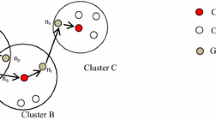Abstract
An ad-hoc wireless network has multihop architecture and is more mobile than single-hop network architecture in the real world. But the ad-hoc wireless network has some challenge with respect to mobility, real-time communication, routing path, maintenance, spatial reuse, bandwidth management, and packets broadcast overhead. This paper investigates two important issues to ensure more stable path routing and less re-clustering to improve the system performance. Novel Linked Stability-Based Clustering (LSC) and Linked Stability-Based Routing (LSR) algorithms, using fuzzy set theory, are proposed. The LSC algorithm guarantees the stability of the cluster to reduce the probability of re-clustering because the cluster-head is not easily replaced. The LSC algorithm proposed in this paper reduces the easy re-clustering problem of the HCC algorithm by considering not only connectivity but also the link's signal strength between the mobile nodes obtained from a fuzzy set in cluster-head determination. The membership function of the LSC algorithm, based on the link's signal strength, predicts a more stable link routing path using fuzzy set theory. Simulation results show that the proposed algorithm ensures the stability of the cluster and avoids unnecessary re-clustering; for example, the LSC algorithm occurs less frequently than LID and HC algorithms. Similarly, the LSR routing algorithm that uses fuzzy sets and membership functions is based on the mean signal strength and the relative movement between nodes, to obtain the lifetime of each connection and the path lifetime, from fuzzy inferences and fuzzy rules for reference. The LSR algorithm provides more reliable path lifetime and more stable transmission than the table-driven or on-demand approaches. Simulation results reveal that the path lifetime of the LSR algorithm is longer than that of DSR, with a lower probability of path drop and avoiding rerouting. The LSR algorithm has a higher mean number of hoppings, because it always finds the most suitable path and is more stable than DSR, without searching again for a new path when the paths drop.
Similar content being viewed by others
REFERENCES
E. M. Royer C.-K. Toh, “A Review of Current Routing Protocols for Ad Hoc Mobile Wireless Networks,” IEEE Pers. Commun., Vol. 62, pp. 46–55, April 1999.
S.-J. Lee, M. Gerla, and C.-K. Toh, “A simulation Study of Table-Driven and On-Demand Routing Protocols for Mobile Ad Hoc Networks,” IEEE Netw, Vol. 13 4, pp. 48–54, July-Aug. 1999.
S. R. Das, C. E. Perkins, and E. M. Royer, “Performance Comparison of Two On-Demand Routing Protocols for Ad Hoc Networks,” INFOCOM 2000. Proceedings of the 19th Annual Joint Conference of the IEEE Computer and Communications Societies. IEEE Vol. 1, pp. 3–12, 2000.
J. Broch, D. A. Maltz, D. B. Johnson, Y. C. Hu, and J. Jetcheva, “A Performance Comparison of Multi-HopWireless AD Hoc Network Routing Protocols,” in Proc. 4th Annu ACM/IEEE Inter. Conf. Mobile Comput. Netw. pp. 25–30, Oct. 1998.
S. R. Das, R. Castaneda, J. Yan, and R. Sengupta, “Comparative Networks,” Proceedings of 7th International Conference on Com-puter Communications and Networks, pp. 153–161, 1998.
M. Gerla and J. T. C. Tsai, “Optimized Link States Routing Protocol,” IEEE Comput Commun. Conf., pp. 78–95, Feb. 1999.
D. Waitzman, C. Partidge, and S. Deering (editors), Distance Vector Multicast Routing Protocol, RFC 1075, BBN STC, and Stanford University, pp. 89–102, Nov. 1988.
C.-C. Chiang, “Routing in Clustered Multihop Mobile Wireless Networks with Fading Channel,” Proc. IEEE SICON, pp. 197–211, Apr. 1997.
T.-C. Hou and T.-J. Tsai, “Adaptive Clustering in a Hierarchical Ad Hoc Network,” Proceedings of the 1998 International ComputerSymposium, Workshop on Computer Networks, Internet, and Multi-media, pp. 171–176, Dec., Taiwan, 1998.
S. Basagni, “Distributed Clustering for Ad Hoc Networks,” Proceedings of the 4th International Symposium on Architectures, Algo- rerithms, and Networks, pp. 310–315, 1999.
T. J. Kwon and G. M. Military, “Clustering with Power Control,” Communications Conference Proceedings, 1999, MILCOM, IEEE Vol. 2, pp. 1424–1428, 1999.
C. R. Lin and M. Gerla, “Adaptive Clustering for Mobile Wireless Networks,” J. Select Areas Commun., IEEE Vol. 15 No. 7, pp. 1265–1275, Sept. 1997.
S. Murthy and J. J. Garcia-Luna-Aceves, “An Efficient Routing Protocol for Wireless Networks,” J. ACM Mobile Netw and App. (Special Issue on Routing in Mobile Communication Networks), pp. 183–197, Oct. 1996.
C. E. Perkins and P. Bhagwat, “Highly Dynamic Destination-Sequenced Distance-Vector Routing (DSDV) for Mobile Computers,” Proceedings of ACM SIGCOMM, pp. 234–244, Oct. 1994.
C. E. Perkins and E. M. Royer, “Ad-Hoc On-Demand Distance Vector Routing,” Proceedings of the 2nd IEEEWorkshop on Mobile (if-else then) Computing Systems and Applications, ‘99 pp. 90–100, Feb. 1999.
D. B. Johnson and D. A. Maltz, “Dynamic Source Routing in Ad Hoc Wireless Networks.” In Mobile Computing, edited by T. Imielinski and H. Korth, Kluwer Academic Publishers, Phoenix, Arizona, pp. 153–181, 1996.
K. Paul, S. Bandyopadhyay, A. Mukherjee, and D. Saha, “Communication-Aware Mobile Hosts in Ad-hoc Wireless Network,” IEEE International Conference, Pers. Wireless Commun., pp. 83–87
R. Dube, C. D. Rais, K. Y. Wang, and S. K. T ripathi, “Signal Stability-based Adaptive Routing (SSA) for Ad Hoc Mobile Networks,” IEEE Pers. Commun. Vol. 41, pp. 36–45, Feb. 1997.
Z. J. Hass and M. R. Perlamn, “The Zone Routing Protocol (ZRP) for Ad Hoc Networks,” Internet draft, pp. 46–55, Nov. 1997.
D. B. Johnson and D. A. Maltz, “The Dynamic Source routing Protocol for Mobile Ad Hoc Networks,” Proc. IEEE INFOCOM 1998, pp. 26–41.
T. S. Rappaport, Wireless Communications, Communications Engineering and Emerging Technologies Series, Prentice Hall New York, 1996.
H. J. Zimmermann, Fuzzy Set Theory and Its Applications, 2nd ed., Maw-Chang Book Company, Taiwan, 1991.
D. Baker et al., “Flat Vs. Hierarchical Network Control Architecture,” ARO/DARPA Wksp. Mobile Ad-Hoc Networking, March.
C.-C. Liu, “Link Stability-based Routing and Clustering in Ad Hoc Wireless Networks Using Fuzzy Set Theory,” M.S. Thesis, Institute of Computer Science and Information Engineering, Yuan-Ze University, June 1997.
Author information
Authors and Affiliations
Rights and permissions
About this article
Cite this article
Hwang, IS., Liu, CC. & Wang, CY. Link Stability-Based Clustering and Routing in Ad-Hoc Wireless Networks Using Fuzzy Set Theory. International Journal of Wireless Information Networks 9, 201–212 (2002). https://doi.org/10.1023/A:1016089728699
Issue Date:
DOI: https://doi.org/10.1023/A:1016089728699




